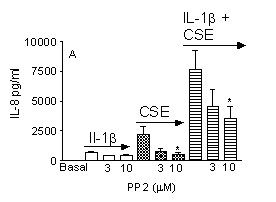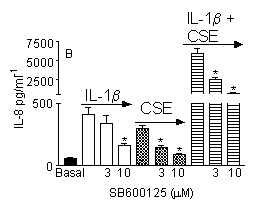| pA2 online © Copyright 2004 The British Pharmacological Society |
050P
University of Bath Summer Meeting July 2004 |
|
Downstream signalling pathways involved in the activation of IL-8 release from THP-1 monocytes by cigarette smoke |
|
COPD is a leading cause of morbidity and mortality, the main causative agent being cigarette smoke, with cessation of smoking being the only way to slow disease progression (Culpitt et al, 2000). We have previously shown that cigarette smoke extract (CSE) is capable of initiating release of IL-8 from THP-1 monocytes and that it synergises with IL-1β in chemokine release (Walters et al, 2003). The mechanism of the synergy between CSE and IL-1β is not known. We have therefore investigated downstream signalling pathways activated by CSE and IL-1β in THP-1 monocytes.
Briefly CSE was made by bubbling mainstream cigarette smoke from 4 Marlboro cigarettes into 100ml RPMI 1640. This was then filter sterilised and diluted with non smoked medium to the desired concentration (Walters et al, 2003). Total NF-κB (p50 & p65) levels were assayed after 1hr treatment with IL-1β, 10% CSE or a combination of both. CSE in combination with IL-1β caused a significant increase in both p50 (197.5% of control) and p65 (208.2% of control) activation (p=<0.001 n=3). CSE alone did not significantly affect NF-κB activation (p50 78.1%, p65 89% of control), NF-kB was not further increased when cells were treated with IL-1β plus CSE (p50 170.2% p65 203% %control; n=3). In separate experiments PP2, a selective inhibitor of Src kinases (Hanke et al, 1996) or SB600125, an inhibitor of c-Jun N-terminal kinase were added to cells 20mins prior to stimulation.
Figure 1 Figure 2


Inhibition of IL-8 release by PP2 (Figure 1) or SB600125 (Figure 2) by THP-1 monocytes stimulated with either 10% CSE, IL-1β (1ng/ml-1) alone or in combination. (n=9 from 3 experimental day, OneWay ANOVA with Dunnets post test *=P<0.05, **=p<0.001).
PP2 inhibited IL-8 release stimulated by CSE or CSE plus IL-1β , but not by IL-1β alone (Figure 1). By contrast, SB600125 inhibited IL-8 release induced IL-1β , CSE or the combination of IL-1β plus CSE, at 3μM (Figure 2).
These observations suggest that CSE activates cells via the Src kinases and JNK pathways, whilst NF-κB does not appear to be involved. We suggest that Src kinases and JNK may be cellular targets in the development of treatments for smoking released disease.
Culpitt S., et al(2000) Expert Opin Pharmacother, 1(5), 1007-20
Hanke J., et al(1996) J. Bio. Chem. 271(2) 695-701
Walters M.J, et al (2003) Brit. J. Pharmcol ,138, 44P
This work was supported by a research grant from the MRC and Yammanouchi